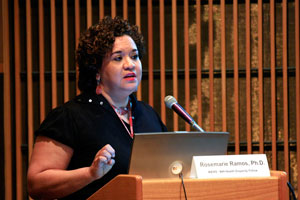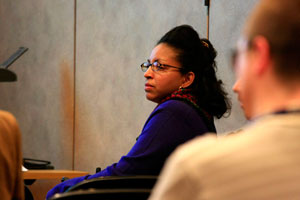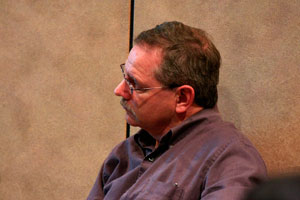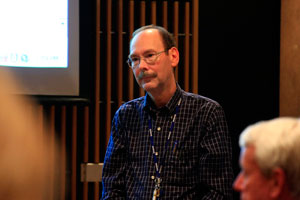
Environmental Factor, June 2008, National Institute of Environmental Health Sciences
Ramos Urges Expanded Planning for Emergencies
By Eddy Ball
June 2008




America’s 21st century disasters have led to some important work at NIEHS, including the research conducted by NIEHS/NIH Health Disparities Fellow Rose Ramos, Ph.D. Ramos, who works with the Metastasis Group, offered her thoughts on the need to “Prepare and Protect Vulnerable Populations for Emergencies” April 22 in Rodbell Auditorium and the connections with the NIH/NIEHS public health agenda.
The talk was sponsored by the NIEHS Disability Advocacy Committee (DAC) and hosted by DAC Chair Alicia Moore. People with disabilities are among the populations Ramos described as especially vulnerable to the danger and disruption caused by such events as the World Trade Center disaster and Hurricanes Katrina and Rita.
“Vulnerable populations are defined by the National Association of County and City Health Officials,” Ramos began, “as those individuals with special needs who, after exhausting all other resources, still need assistance before, during and possibly after a disaster or emergency.”
The incidence of these emergencies is on the rise, according to Ramos, because of extreme natural events triggered by global climate change and such manmade disasters as chemical spills and terrorist attacks. Of the ten essential public health services listed by the American Public Health Association(http://www.apha.org/programs/standards/performancestandardsprogram/resexxentialservices.htm) ![]() , Ramos said, “three of them are very relevant to emergency preparedness”: identifying community health problems, mobilizing community partnerships and linking people to needed personal health services.
, Ramos said, “three of them are very relevant to emergency preparedness”: identifying community health problems, mobilizing community partnerships and linking people to needed personal health services.
The United States faces several challenges in planning for disasters, Ramos explained. Because emergency preparedness has typically been primarily a state and local concerns, there are marked geographic disparities in resources and the certification of local public health department emergency readiness. Most of the country’s public health departments, she noted, “ranked with the equivalent of a C, D or F.”
According to Ramos, compounding the problem are significant differences in the geographic distribution of people with chronic and potentially life-threatening illnesses or other special needs, which make them especially vulnerable to the additional emotional and physical stress caused by emergencies. Several of the states with the greatest needs in this respect are also states with the weakest public health infrastructure. In addition, Ramos lamented, the number of public health training programs is declining just when the need for public health professionals has never been greater.
Ramos outlined recent Department of Health and Human Services (HHS) initiatives for emergency preparedness. These include the 2006 Pandemic and All-Hazards Preparedness Act mandating HHS to coordinate additional planning and research and the Centers for Disease Control and Prevention Centers for Public Health Preparedness. Within HHS, the Biomedical Advanced Research and Development Authority (BARDA) is charged with providing an integrated, systematic approach to the development and purchase of the necessary vaccines, drugs, therapies and diagnostic tools for public health medical emergencies.
While government resources need to be expanded and improved, Ramos argued, there are several steps that individuals need to take on their own. People need to make their representatives aware of citizens’ concerns about disparities in public health preparedness. Individuals can take advantage of existing cell phone and global positioning technology alert systems and maintain an electronic record of prescriptions.
Families should plan ways to help their vulnerable members and know about emergency plans at their children’s schools. As members of communities, people can also take on the attitude, as Ramos said, that “I am my brother’s keeper” and look out for their vulnerable neighbors.
As part of a presentation that touched several times on global warming and the disproportionate impact of rising gasoline and energy prices on vulnerable populations, Ramos included Earth Week tips at transition points in her lecture. Emergency preparedness, she emphasized, is an environmental issue as well as a public health concern, and efforts to achieve greater sustainability can ultimately impact both.
Recent Health Disparities Research at NIEHS
On April 29, the American Journal of Public Health posted a health disparities study on-line ![]() (http://www.ajph.org/cgi/reprint/AJPH.2007.120055v1) authored by Ramos and her mentor, NIEHS Director Emeritus and Metastasis Group Chief Ken Olden, Ph.D., that will appear in the journal’s June 2008 issue. As far as the authors are aware, the paper, titled “The Prevalence of Metabolic Syndrome Among US Women of Childbearing Age,” is the first systematic examination of metabolic syndrome among women of childbearing age as a separate group using survey-specific data analysis methods to examine data from the National Health and Nutrition Examination Surveys conducted from 1988 to 2004.
(http://www.ajph.org/cgi/reprint/AJPH.2007.120055v1) authored by Ramos and her mentor, NIEHS Director Emeritus and Metastasis Group Chief Ken Olden, Ph.D., that will appear in the journal’s June 2008 issue. As far as the authors are aware, the paper, titled “The Prevalence of Metabolic Syndrome Among US Women of Childbearing Age,” is the first systematic examination of metabolic syndrome among women of childbearing age as a separate group using survey-specific data analysis methods to examine data from the National Health and Nutrition Examination Surveys conducted from 1988 to 2004.
The study’s findings are reason for public health concern. Among all women, the prevalence of the metabolic syndrome phenotype, obesity and elevated levels of the cardiac-risk marker C-reactive protein increased during the period between 7.6 percent and 13.3 percent — underscoring a persistent and growing threat to the women’s health. The study determined as well that a disproportionate percentage of Hispanic and non-Hispanic Black women, as compared to White women, experienced metabolic syndrome. Finally, the study found that Women who reported that their mothers had been diagnosed with diabetes were nearly twice as likely to develop the condition as those whose mothers had not been so diagnosed — suggesting the role of intrauterine exposures in perpetuating the condition from one generation to the next.
The study is important for the public health community because of its documentation of the increasing prevalence of metabolic syndrome in women of childbearing age, reinforcing the need for expanded educational programs, awareness by primary care providers and initiatives to improve nutrition and exercise patterns. It also points to health disparities that should be further researched to identify modifiable genetic/epigenetic and environmental factors leading to the higher prevalence among women from certain groups. Results of that research may have the potential to be translated into tailored interventions for minority women and the formulation of policies to promote equity.
"Autism Town Hall Meeting..." - previous story ![]()
![]() next story - "Environmental Justice Grantee..."
next story - "Environmental Justice Grantee..."
June 2008 Cover Page



